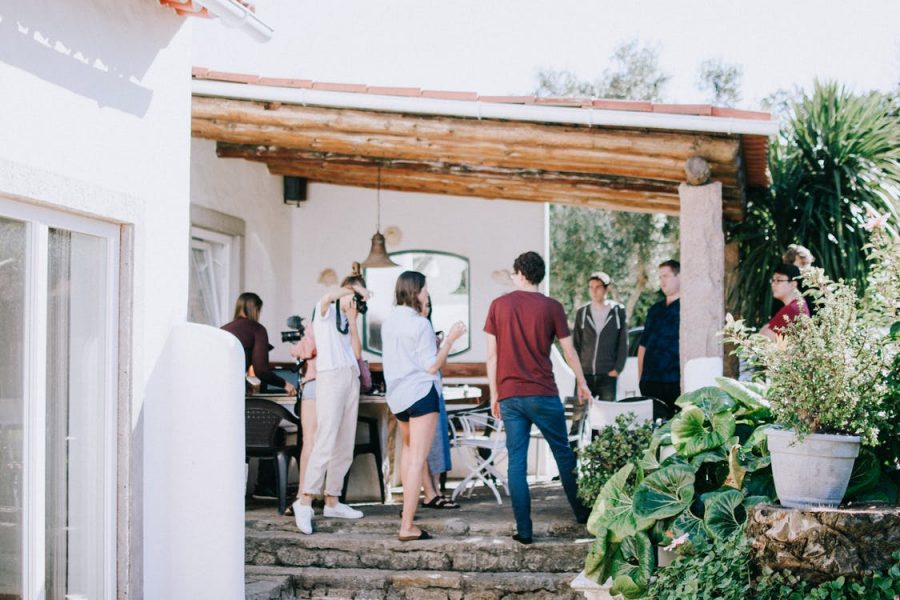Need more space in your home? Why don’t you build or create an outdoor living space? Outdoor rooms and spaces can be a casual extension of your indoor living area. They can give you an excellent place to relax and spend time outside among the plants, the stars, and the beauty of the outdoors. When you are ready to design your own outdoor living area, rehaul your backyard, or just make improvements, set aside some time to do a little planning.
To see how outdoor spaces can add beauty to your home, we have added several tips to help you design your outdoor living areas.
Use Complementary Colors
Before adding an outdoor sitting area, decide on a color scheme and a style for your outdoor living space. Start by analyzing your garden or yard. So, for example, if your garden has that country cottage look, consider using modern rustic decor. Just make sure there is enough seating area to help everyone gather around. When choosing plants, consider the color of the leaves and the blooms throughout the season. As an example, if you have red furniture, purple shrubs might clash, but white flowers and neutral grasses would complement the red paint.
Divide The Area Into Zones
Separate the zoning areas to make the most of the backyard. For example, you could separate the dining and lounging areas slightly from each other by using paved walkways and other garden dividers to get the separate area effect. You can also use screens and trellises, and oversized planters. If you want to have beautiful landscaping for your home, it requires a good design and a lot of care.
The design is where you will want to start for beautiful landscaping, and a good choice of plants will help reduce maintenance and make your landscaping hardy.
Native Grass Choices Add Color and Texture
Native grasses give you great options for adding color to your landscaping design, such as using species with shorter blade lengths or light and dark shades of green. The native grasses in most climates are a great choice to bring borders around paths and flower beds to life. For taller grasses, they are a great addition to bare areas of flowerbeds or to accent features like rock gardens. When choosing grasses for your landscaping, pick species that grow in the wild near your home.
Use Matching Furniture and Potted Trees
Matching finishes will add harmony to your furniture. Just be sure to use furniture that is for outdoor use. A good idea is to use rattan or wrought iron furniture with outdoor cushions. This popular choice adds a timeless look. Consider using trees in pots if you want to combine greenery with the patio or outdoor living area. If you are planning on moving soon or only plan to stay at your house for a few years, potted plants can be moved with you!
Create a Dining Area
Consider calling a concrete company to create a cement slab that is big enough to make an outdoor bar or dining area. Relying on a professional with the equipment needed for the job will yield the best results. Once you complete that attractive patio area, you can choose dining or bar furnishings made of natural materials and finishes. Use wood, oak, rattan, or wrought iron for outdoor bars and dining areas. Add stylish pots and outdoor lanterns to finish the look.
Choose a Variety of Native Flowering Shrubs for Colorful Blooms All Year
Your locally native flora also provides you with a wonderful selection of flowering shrubs, which include many species of azalea and laurels. There are different sub-species of many of these plants that are only found in the wild in certain areas, and you will want to use species that are native to a region with a climate like yours. In addition to flowering shrubs, you may also want to consider using native grape species for climbing plants and vine features in your landscaping design. Using flowering plants native to your area also brings the added benefit of attracting pollinators like bees and butterflies.
Design the Lighting Scheme
When designing outdoor areas, you must approach your outdoor areas by thinking of your lighting. Approach the lighting design as you do for your home interior. Look for intimate lighting and not bright and glaring.
Think of using different levels of light fixtures. For example, you might use ground lights that illuminate trees and shrubs. You can use table lights or lights strung from trees and shrubs. If you don’t have electric outlets, choose solar-powered lights or battery-powered LEDs to meet your needs.
Plant Trees for Shade for Shade
Trees are one of the most important choices when choosing plants for your outdoor living spaces. There are some species that you may want to avoid if possible, which are those that are vulnerable to disease and insect problems. For example, pine species are vulnerable to attack from invasive beetle species, or ash trees that are susceptible to attack by the invasive emerald ash borer. Choosing smaller hardwoods like dogwood or hickory will make maintenance easier, as well as make it easier to replace them if they do get attacked by a disease or insect infestation.
By looking at different magazines, you can find many other design and placement ideas. Consider what hardscaping features you want as well as what plants you are adding. Just be sure you get the above basic ideas in place, and you can add any style idea you want.



